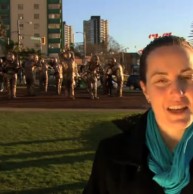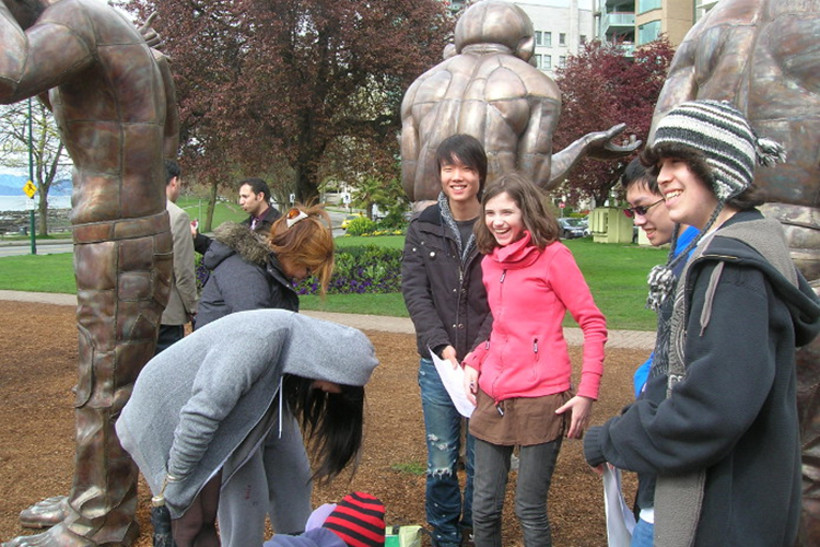A-Maze-ing Laughter
Arts Education, Planning, Physical Education, Science, Social Studies
Sculpture Title:
Learning Lens:
Health and Social Education
Curriculum Access:
Arts, Drama, Career and Personal Planning, Physical Education, Psychology, Science, and Social Studies
BIG IDEA:
Freedom of Expression and Censorship
Guiding Question:
Why is it important to mindfully feel and express all of my feelings and ideas?
*Note: this lesson contains several parts that can be applied individually or as a whole.
Related Discussion Topics:
Mindfulness, unruly minds/emotions (anxiety, stress, medical issues, life stressors, thought patterns, healthy self-defeating behaviours, low self-esteem, depression), relationships, and physical activity.
Strategies and Approaches:
Teamwork; Socratic Questioning; informal assessment; prompting; drama exercises; experiential learning; physical challenges; public presentations, critical thinking
Background for Students:
Through discussion, students form an understanding of the important factors needed to build a healthy mindful life. Do they understand that mindfulness is an everyday practice that can help with unruly minds, bodies, and relationships? This is because stress can affect their bodies and their mental and physical health. They understand the need to take a minute to detach from their chaotic environment and take a step back. They form an understanding that disentangling from their environment can be very difficult at times, but if they work to undo that knot they will be able to create a better selves, an authentic people that can help themselves, the world, their school, and their community.
Materials:
Art supplies (markers, poster board, newspapers and magazines, tape, etc)
Curriculum challenge:
(this is an extended challenge that may be broken into two or more parts)
20 mins, Exercising for Mental Wellness
Teacher guides students through physical challenges to have them think about their emotions and their bodies’ natural responses. We will explore ‘mental/external’ blocks to ones’ expression using the following strategies:
1. Challenge students to talk freely amongst themselves without using the letter ‘S’ in any of their words. Teacher can provide students with a topic to encourage communication.
2. While they are moving around and chatting, challenge students to move in a certain way using varied locomotor patterns, speeds and levels. For example, walk in ‘high, medium and low levels’. Move quickly, move very slowly. Walk a different way such as backwards or sideways.
3. Have the students move as if they were portraying an emotion such as anger or happiness. Challenge the students to incorporate feelings by moving one way and looking another. For example, move as if you were depressed but look as if you were surprised.
10 mins, Practicing Mindfulness in a Challenging Context
1. Students are encouraged to disengage from their recent experience and their busy surroundings to practice mindfulness.
2. Direct students to ‘mindfully’ (quietly/individually) explore the piece and develop their own interpretation. More information on mindfulness for the classroom can be found here.
3. Direct each student to share their interpretation of the piece without judgement.
4. Connect students’ individual interpretations to the background information provided above.
5 mins, Lesson: What Is Censorship and Freedom of Expression?
Using Socratic Questioning (big group discussion) ask the students to define Censorship and Freedom of Expression.
45 mins, Introduction of Activity: A Challenge Relating to Feelings, Expression, and Community
1. Students will be presented with a current event affecting their province and their lives. For example, students can examine a story about cuts to education budgets. Using newspaper clippings students will learn about potential challenges facing education and think critically about what education should be like for students in BC?
2. Students will form small groups and will be asked to answer the question. Teams will be encouraged to express themselves in any way they wish (dance, song, art, mime, etc). They will have 20 minutes to complete the assignment and practice their presentation. If required, materials such as poster boards, markers, props and magazines will be available.
3. Students will present their creative pieces to a panel. The panel will not say anything about the presentation until the very end. The panel can be made up of supervisors or students.
4. After the presentation, the panel will individually tell each group what they need to change. The panel will enforce their own type of censorship by restricting expressions, colours, ideas, or words. For example, a poster cannot use the colour purple.
5. Students will modify their expression accordingly and re-present to panel.
10 mins, Debrief:
Debrief censorship activity and wellness exercises: the importance of practicing mindfulness and freedom of expression (feelings associated when this is blocked) and link this back to the art piece. For example, topics you may want to touch upon are countries where freedom of expression is censored.
Related Material
 Freedom of Expression & Censorship
Freedom of Expression & Censorship